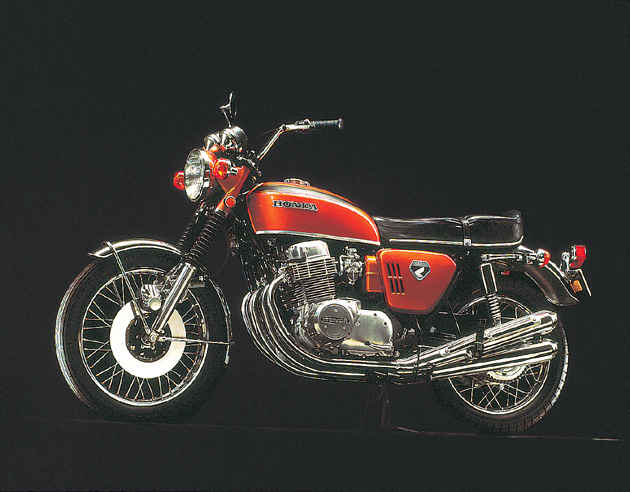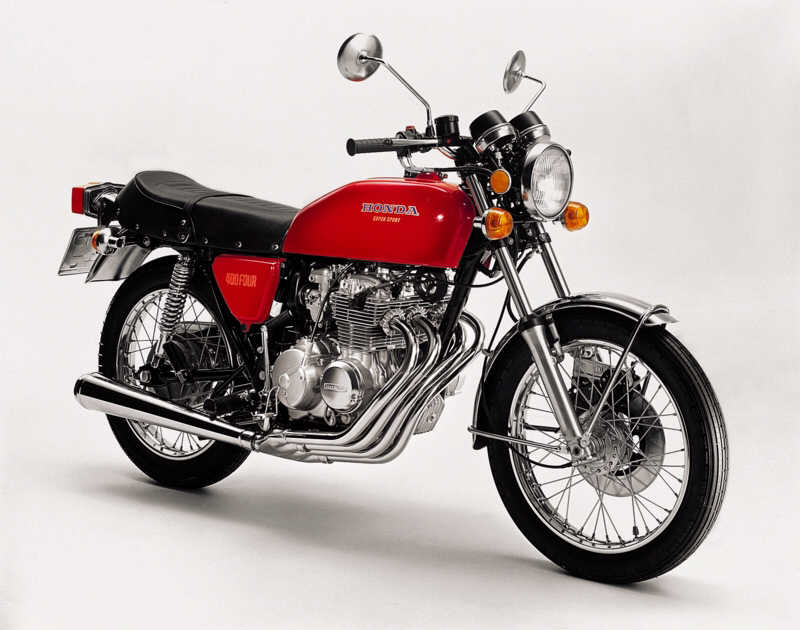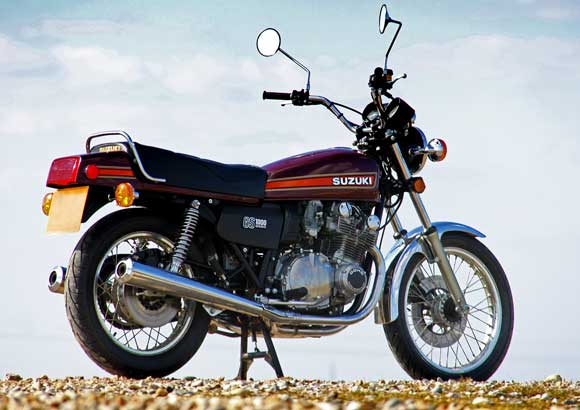4-into-2 – with Phil Hall
When Honda debuted the CB750/4 in 1967, the manufacturer unwittingly created a template, elements of which would still be followed some 50 years after its inception. While it is true that Kawasaki reaped the benefit of holding off on its superbike entry and so created a better bike in the Z1, having learned from Honda’s experience, the fact is that it was Honda who took the plunge into the unknown and created the archetypal superbike.
In my day I rode both bikes and, coming from a smaller bike, as most riders of the day did when graduating to the Japanese models, it was quite a revelation!
If you look at the 750 you can see the design elements that have lasted till today. An across-the- frame 4 cylinder engine. Yes, MV and Gilera and other small manufacturers had built and used a similar design, but mainly in racing and certainly not in mass production. A front hydraulic disc brake. It didn’t take too long for that to become TWO on the front and one on the back, but it was a revelation, if not revolution in the day. Electric start. No more having to learn the knack of kick starting. Of course, for some years, the kick stater was also included until people became used to the idea of the button start and I remember a friend amazing me once by kick starting my 500/4 with his hand! Until he did so I hadn’t realised that a bigger number of smaller pistons was much easier to turn over than a small number of big ones.

But it was the exhaust system that was one of the most outstanding styling features of the 750/4. Four shiny header pipes funnelling into four shiny chrome mufflers. Nothing new here either, really, but again, it was just the way that they did it. Almost since the time when the STYLE of a bike became as important as its performance, manufacturers had realised that the motorcycle exhaust system was an important styling element. I’m not going to dissect this in detail as it is probably just a bit too esoteric, but it was the 4-into-4 exhaust system as introduced in the 750 that again set up a template that would continue for many years.
It was to become almost a trademark for Honda, with their ever-increasing line of four cylinder bikes having it as a common feature. But, as Clarkson used to say, there was a problem.
Build a bike with performance and it won’t take long before the bold and the daring find that the performance could be (and should be) made just a little bit better. And one of the ways that the early 4’s could be made faster (and noisier) was by ditching the 4-into-4 exhaust and fitting a 4-into-1. Time doesn’t permit me the luxury of researching just how long it took before the first example appeared, but my memory says that it wasn’t that long. Why? Well, as I said, there was a problem with the standard exhaust system. Swoopy and attractive as it was, first of all, it was heavy. Four pipes and four big mufflers weighed quite a bit. Less weight=better performance – QED. The standard pipes were designed to not only look good but also to be civilized and to not scare the natives too much.
Those of us that remember the bike will remember that the sound was delicious but hardly offensive. The Japanese sensibilities of a civilized bike were clearly being observed. Fitting a lighter, louder exhaust was not only a performance option, achieved at a reasonable cost, but it also shouted to the observer, “Hey, look at me, I’m riding a 750/4.”
The other problem that hastened the search for an alternative exhaust system was linked to the above concept of a gentle, rather than raucous exhaust system. While the headers were chromed and lasted pretty well, the muffler parts of the system did not. Heavily baffled to avoid offence, the pipes came with, as one journalist put it at the time, “incipient rust”. The problem mainly became apparent when the bikes were used for short runs (as most were). Short running times meant that the condensation that is naturally present in the output of an exhaust system was not burned away by the heat of the exhaust system. Thus, after a short run, the condensation that was present in the system remained and soaked into the baffling of the muffler.
Even though the pipes were fitted with a small drain hole in each of them to allow this condensation to drain away, enough of it remained to start rusting the muffler from the inside out almost as soon as the bikes left the showroom. Anecdotal evidence of the day was that many owners were facing deteriorating exhaust mufflers in under 20,000 miles. Certainly my limited experience with several of the 4’s was that, the effective life of the standard mufflers was worryingly short.
Since the rust worked from the inside out, the arrival of serious issues usually coincided with the mufflers starting to crumble in your hands, the external appearance still being reasonably good. It was quite a shock.
So the after-market industry that quickly grew up to provide all the go-faster bits that 750 and 900 riders were demanding, included manufacturers of after-market motorcycle exhaust systems. (Here it must be said that the standard mufflers on the Z1 were much more robust than those of the Honda. They were, however, still heavy and relatively quiet so the need for a lighter, noisier, pipe was just as critical for Big K owners as well)
And since weight-saving, higher decibel output and “look at me” noise was so important, the 4-into-1 pipe fitted the bill. “Pops” Yoshimura provided the best one, but it was expensive. And, pretty quickly, the 4-into-1 became standard fitment in the rapidly burgeoning modified bike arena.
It took quite some time for the manufacturers themselves to look at ways of improving the appearance and performance of their standard exhaust systems. From memory, when Kawasaki introduced the first major upgrade to the Z1 by increasing the capacity to 1000cc, a 4-into2 exhaust came as part of the package. Honda introduced its first 4-into-1 pipe on the 750 F1 in 1976 and the idea was quickly adopted across the four cylinder range, albeit pretty clumsily as none of the early efforts looked particularly attractive.
The arrival of the 400/4 in 1975 saw the first 4-into-1 that really looked like it belonged rather than being an afterthought. The iconic “bunch of bananas” header pipes that swooped across the front of the engine and fed into a muffler that was in proportion with the rest of the bike, set a standard for many years. Indeed, the bike has become a bit of a classic based very much on that attractive feature.

However, the Japanese factories still clung pretty solidly to an understated design of exhaust system, seemingly abrogating the responsibility of fitting a performance set of pipes to the now huge after-market sector. And even into the 80’s, despite the march of time, Honda, particularly, seemed unwilling to abandon the self-destructing exhaust system. I bought my first CBX550 from the late Lenny Willing’s shop in Wyong in 1983. The bike was just a bit over 12 months old, had 23,000km on it and the mufflers, while swoopy and making lovely noises, were rusted through already. A 4-into1 from Phil O’Brien soon fixed that.
I seem to have deviated a long way from my title, and such things happen when you have an idea of where you want an article to go but the stream of consciousness takes you on a different tack, so perhaps I’d better return.
In the late 70’s and early 80’s, the Japanese bikes were becoming more of production racers than road bikes for the masses (witness Honda’s CB1100R and Suzuki’s Katana.) Still eminently useable as everyday bikes, the focus on performance and racetrack “cred” meant that more “racy” features were being added. And, to my way of thinking, one of the most attractive exhaust systems fitted to bikes of the era was the 4-into-2 of the 1978 Suzuki GS1000. Mimicking the pattern of the Z1000, somehow, along with the rest of the bike, the system looked just “right”.

Trying to remember all these details and get them into a coherent order has been, if you’ll pardon the pun, exhausting, but I’d like to close with the reason that I started to write this article to start with and, as you probably have guessed, it has nothing to do with exhaust pipes at all.
In January of 1978, my brother and I rode from Canberra to Albury to photograph the King of the Weir race meeting at that city’s eponymously named, Hume Weir race track. Set in the floor of a quarry, the venue was either stinking hot or freezing cold with barely any middle ground. In 1978 it was both. As recounted in my “Top Five” article of some time ago, the Saturday was hellish hot, with temperatures around the 40’s. Overnight a huge storm swept in and on Sunday the temperatures were more Arctic and were accompanied by soaking rain.
In the midst of the morass that the pits and surrounding areas became, the magic happened, as Victorian star, Bob Rosenthal, won the big race in the sheeting rain, riding the most unsuitable bike on the grid, a TZ750 Yamaha. The stuff of legends indeed.
As soon as the race finished, we voted to head home, already thoroughly soaked. With only rudimentary riding gear we set off up the Hume, Paul on his XS650 Yamaha twin and me on my 400/4 Honda. Not long after we had cleared Albury, my bike mysteriously faltered and died. I pulled to the side of the road, hit the starter and it chimed into life again, well, almost anyway. It seemed to be running but not on all four cylinders. So we set off again, hoping that the engine would come good. Of course it didn’t. It kept going, but only on 2 pots. By dint of revving its head off and keeping it in 2nd gear, I was able to maintain about 65km/h, flat out.
So, in increasing rain and cold, we ground our way up the highway, Paul riding shotgun for me as I pottered along. By Gundagai we were both in what I now know to be the early stages of hypothermia as our rain-soaked clothes hung on us like lead weights. Somewhere between Gundagai and Yass, the rain eased off then stopped and we rejoiced that the wind would help dry out our sodden riding gear. No such joy for the 400/4, though, that steadfastly refused to exceed the built-up area speed limit.
Just after turning off onto the Barton Highway, the bike suddenly chimed back onto four cylinders, it was such a shock! We rode home at proper speed until the outskirts of Canberra when the rain closed in again and the bike dropped back onto two cylinders. Thoroughly dispirited, we ground our way through town to my home on the southside where we pulled in, wet and exhausted. Remembering that this was the Long Weekend in January, we came inside to find Paul’s wife and mine huddled around the heater, wondering where the summer had gone to.
4-into-2. Yes. Literally! The bike had two coils, one for cylinders 1&2 and the other for cylinders 3&4. These were, as I found out, located on the spine of the chassis, tucked up under and near the front of the fuel tank with the high tension leads sweeping forwards and down to the spark plugs. Placed perfectly to catch the spray from the front wheel as you rode along, they were a sitting duck for shorting out once they had become soaked and this is what had happened. Without a doubt the most uncomfortable and horrible ride I have ever endured.
And somehow, there is a nice symmetry there with a bike whose exhaust system is as recognisable today as it was back then being the main part of the story.























